Abstract
This study utilized rates with hereditary hypothalamic diabetes insipidus (D.I.) in order to explore possible mechanisms which prevent full urinary concentration after acute administration of vasopressin in hypothalamic D.I. and which correct this concentrating defect with prolonged therapy.
It was found: (a) that the concentrating defect persisted even when the urinary osmolal excretion of D. I. rats was reduced to that of normal animals; (b) that the defect was not corrected more rapidly if larger doses of vasopressin were given; (c) that it persisted even when the D.I. rats were deprived of drinking water after vasopressin was given; (d) that there was osmotic equilibration between urine and renal papilla at a time when the concentrating defect was still evident; and (e) that the correction of the defect was associated with progressive and significant rise of the papillary osmolality.
These studies appear to rule out osmotic diuresis, accumulation of exogenous vasopressin, persistent primary polydipsia, or delay in the induction of membrane permeability as causes for the concentrating defect. Rather, subnormal osmolality of the renal papilla, which can be corrected only gradually, accounts for the initial concentrating defect and the long time required for its correction. Reduction of water content and increase of urea content are primarily responsible for restoration of papillary osmolality to normal.
Full text
PDF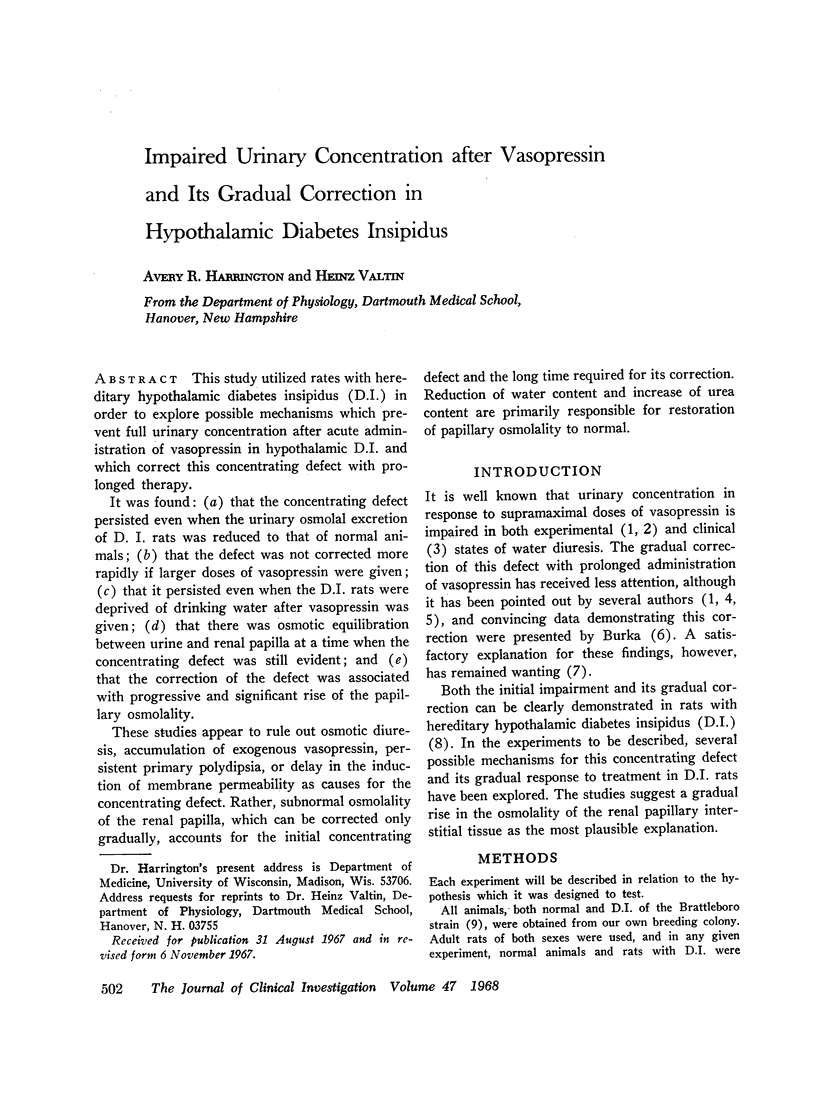
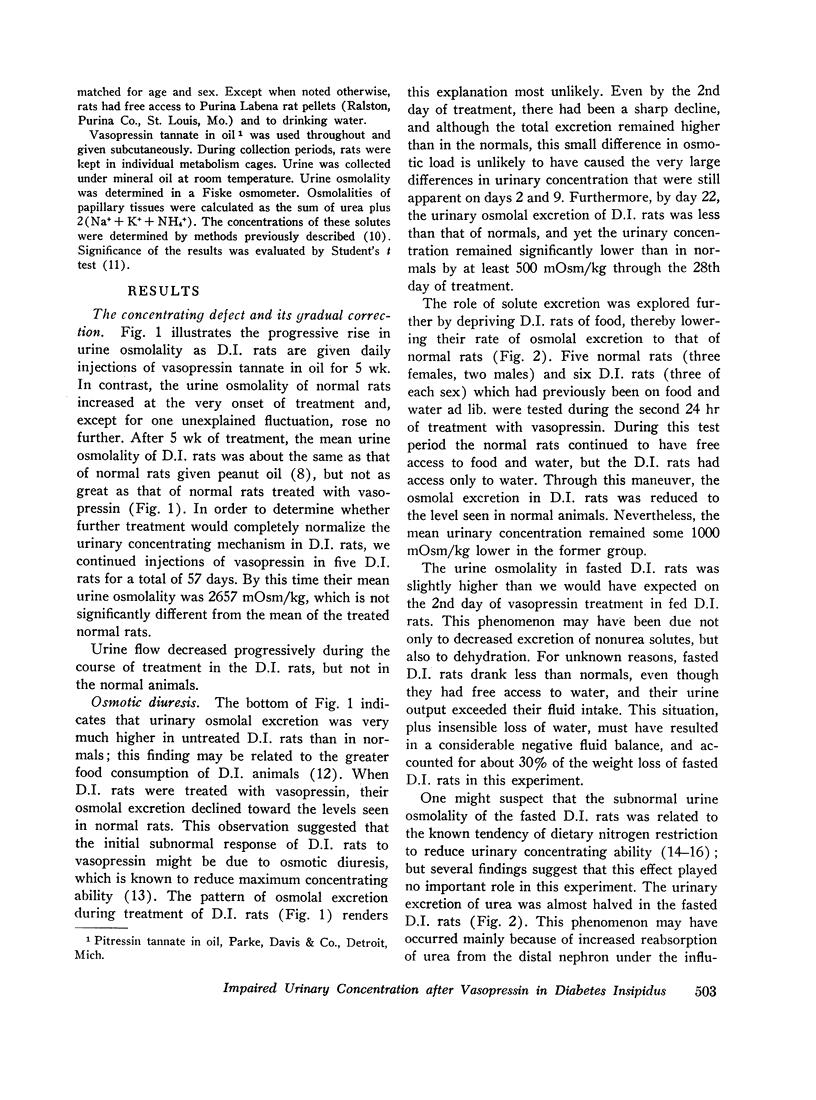
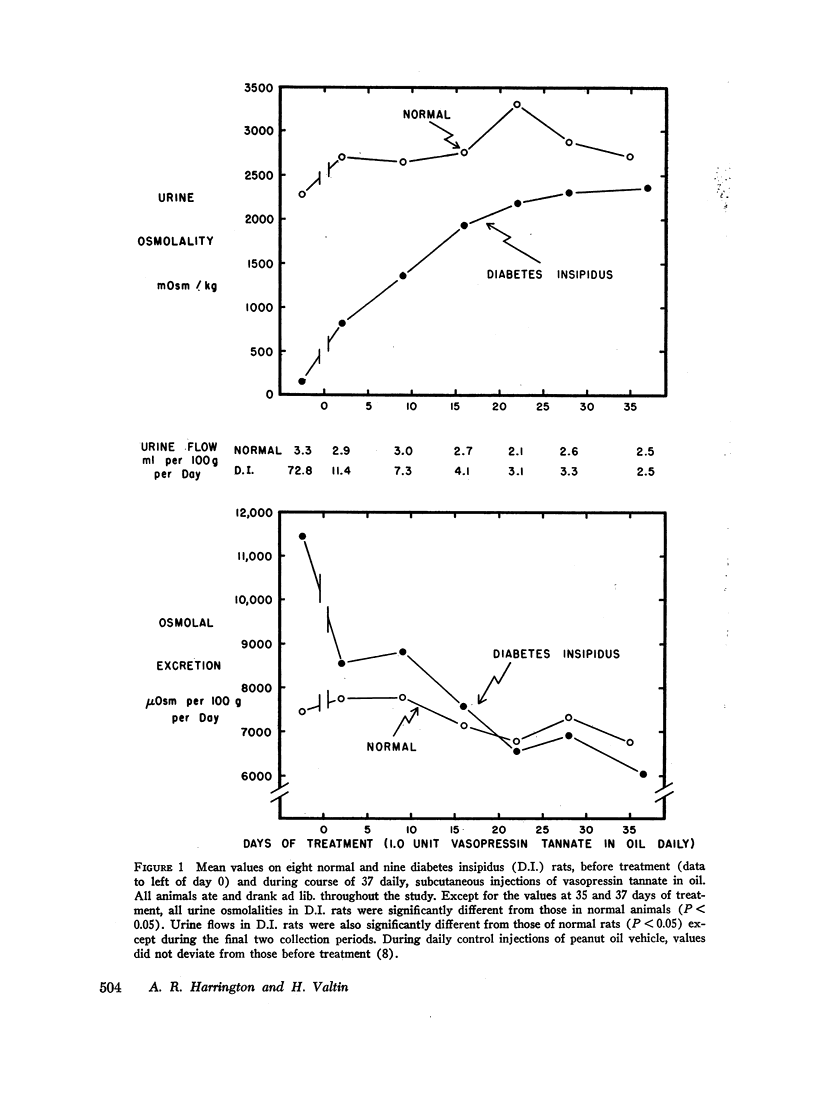
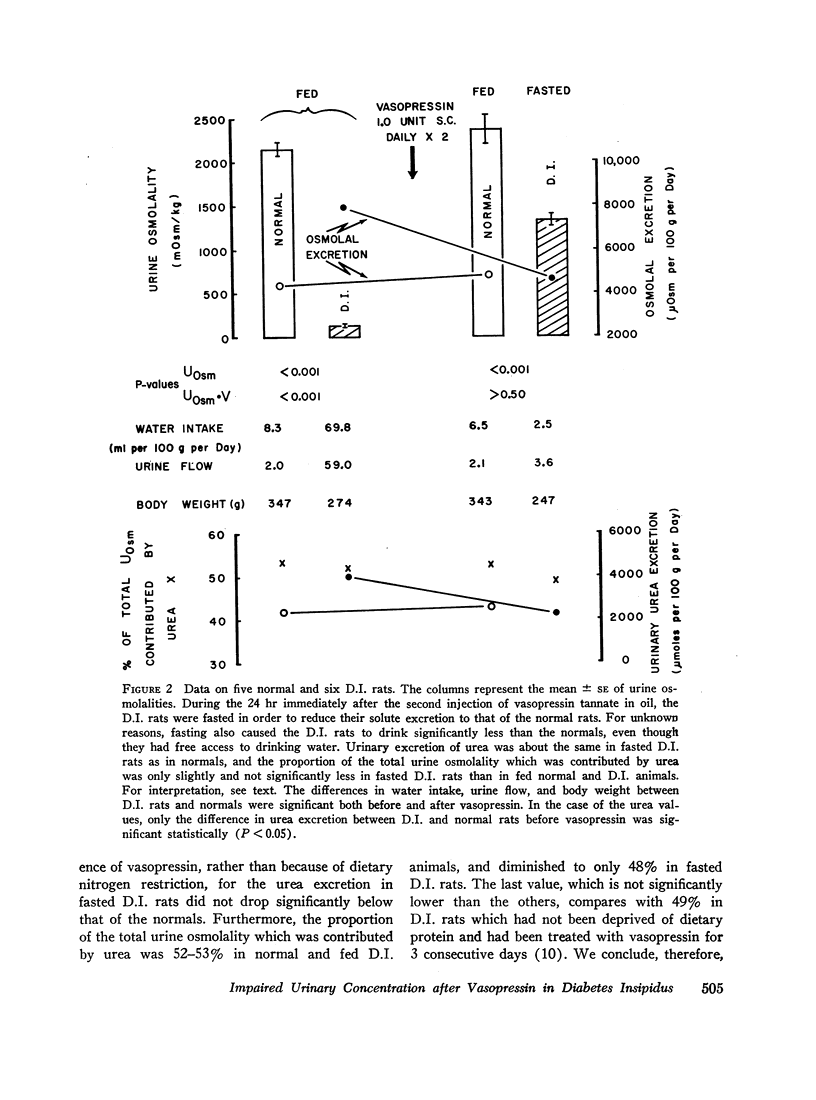
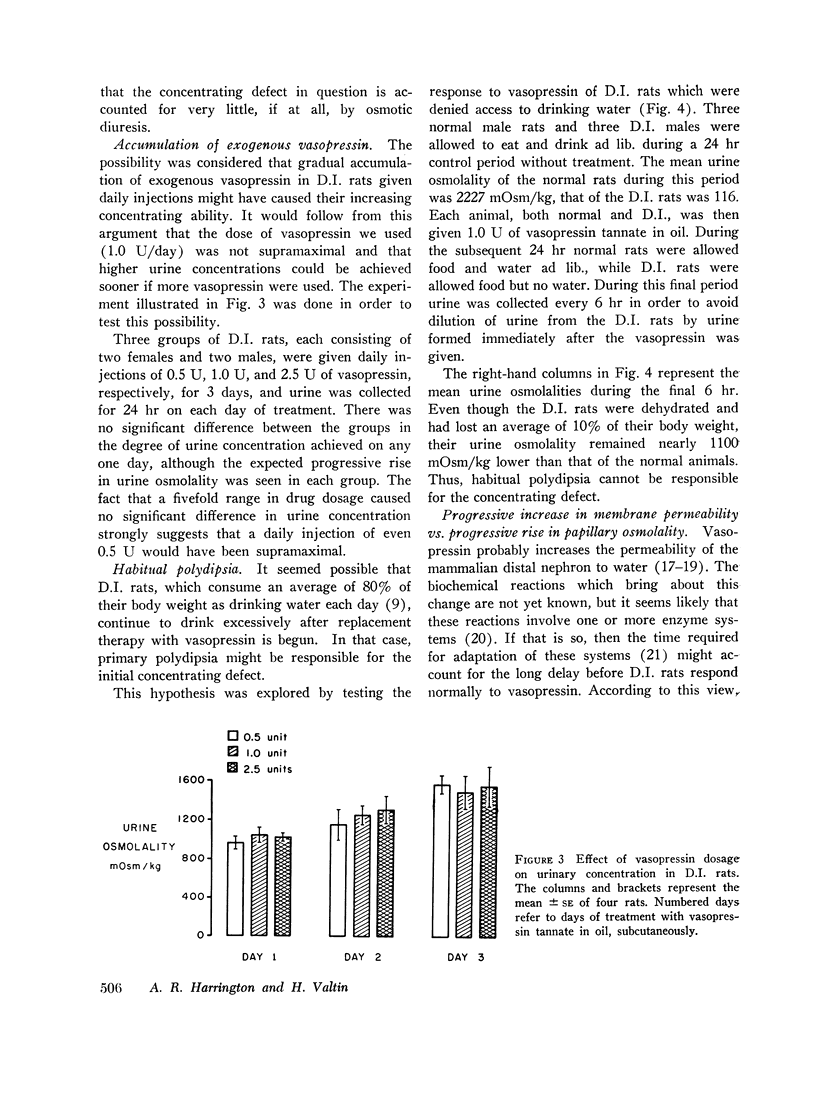
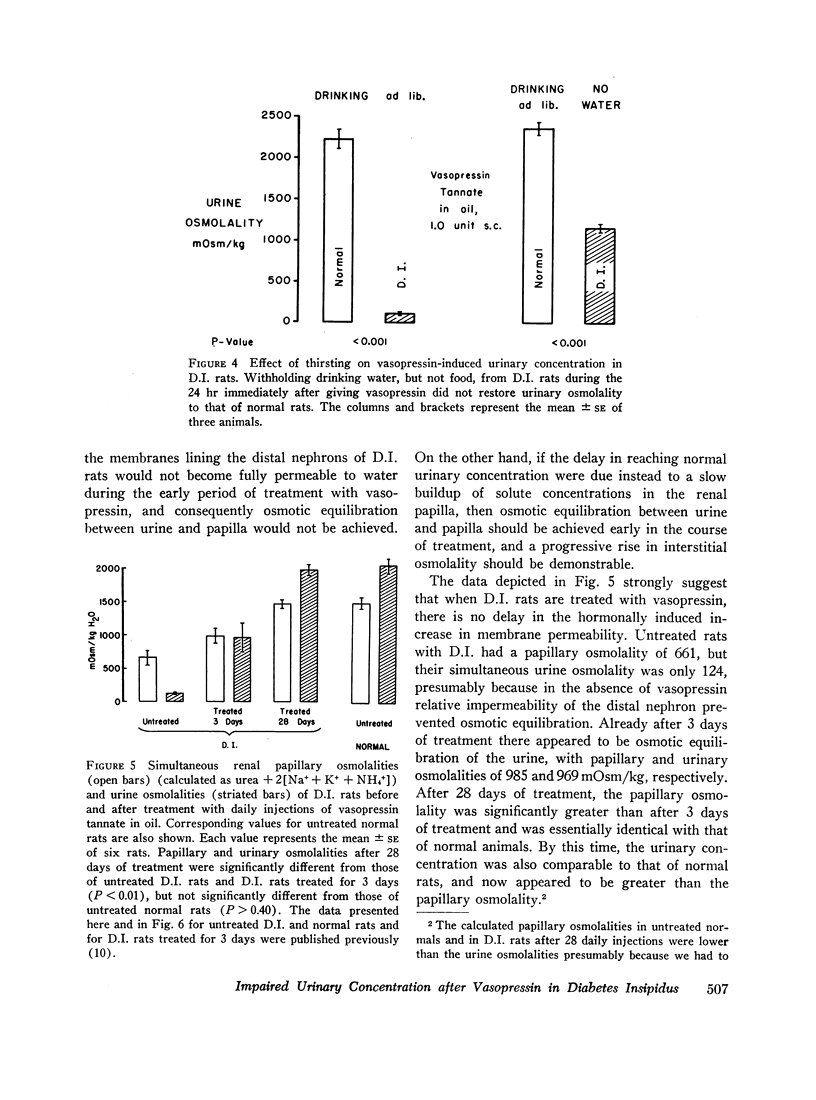
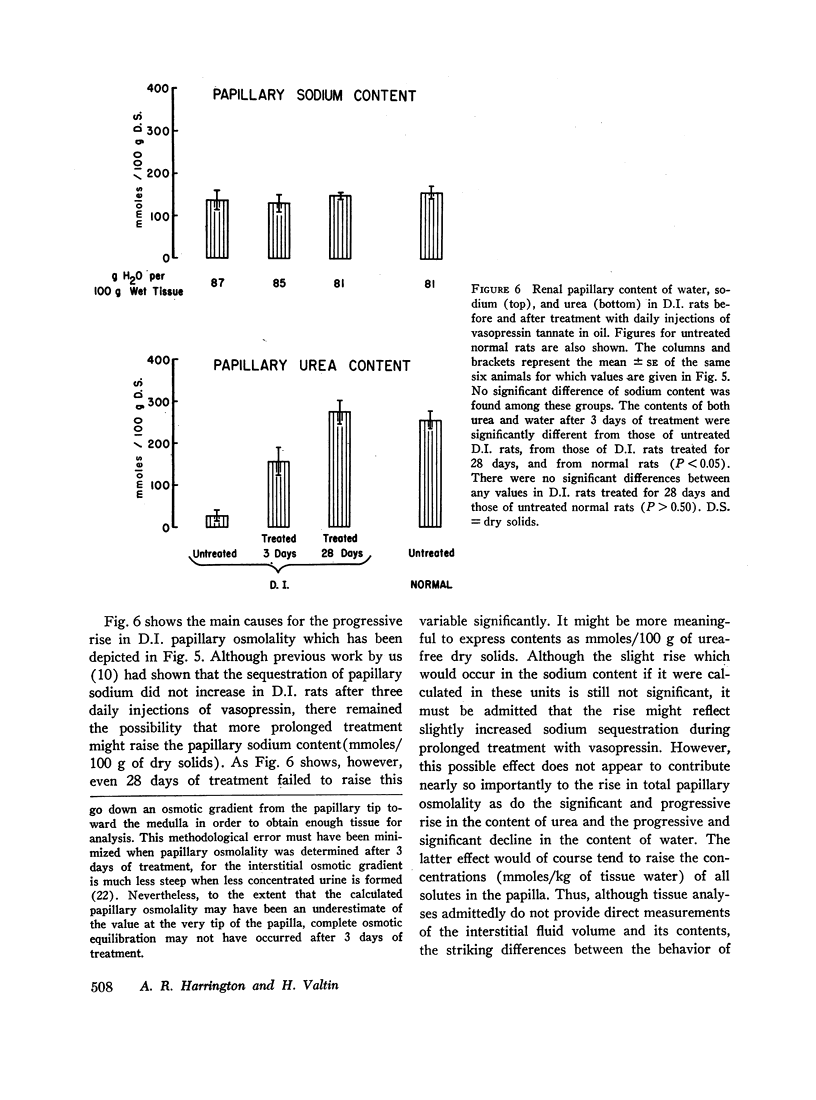
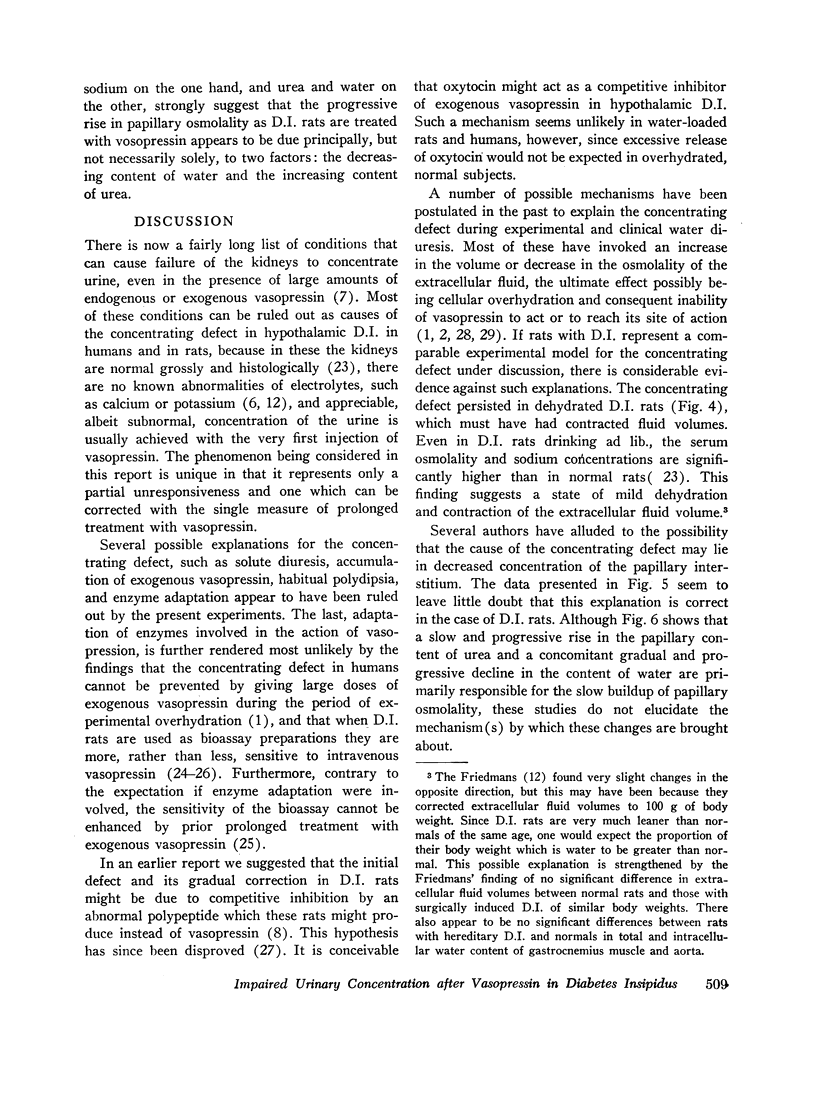
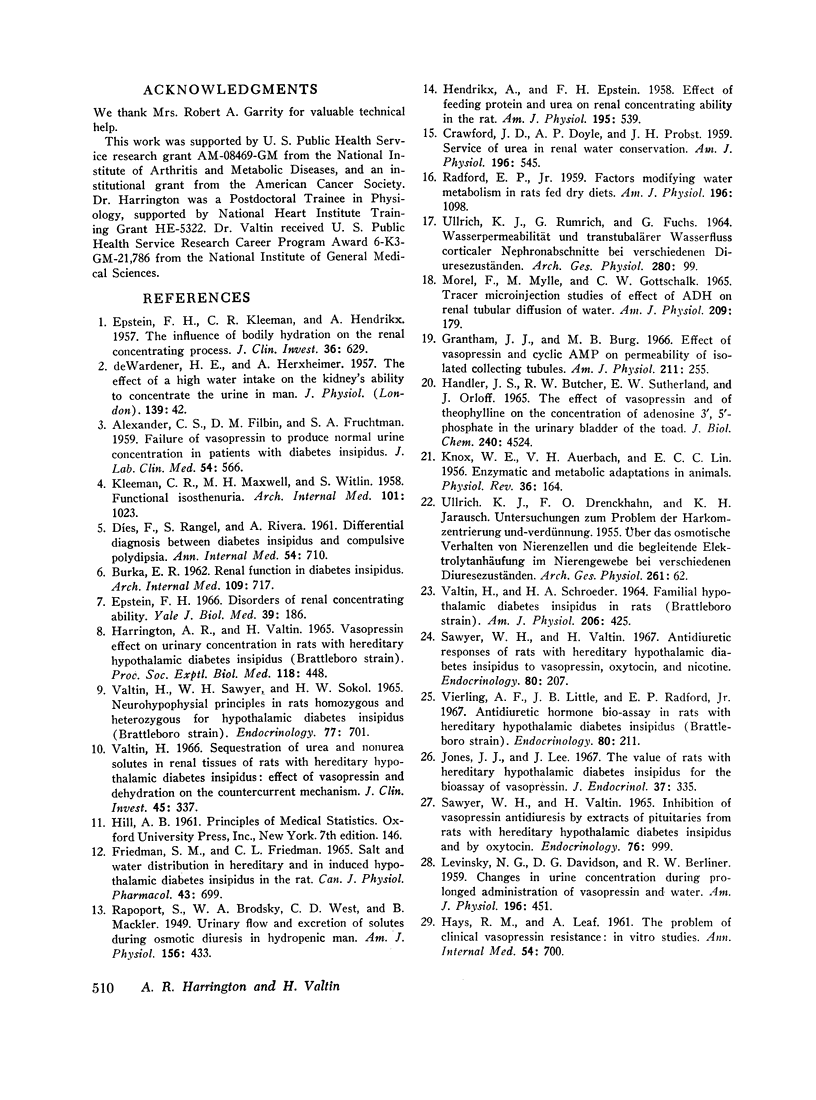
Selected References
These references are in PubMed. This may not be the complete list of references from this article.
- ALEXANDER C. S., FILBIN D. M., FRUCHTMAN S. A. Failure of vasopressin to produce normal urine concentration in patients with diabetes insipidus. J Lab Clin Med. 1959 Oct;54:566–571. [PubMed] [Google Scholar]
- BURKA E. R. Renal function in diabetes insipidus. Case untreated for seventeen years. Arch Intern Med. 1962 Jun;109:717–723. doi: 10.1001/archinte.1962.03620180079009. [DOI] [PubMed] [Google Scholar]
- CRAWFORD J. D., DOYLE A. P., PROBST J. H. Service of urea in renal water conservation. Am J Physiol. 1959 Mar;196(3):545–548. doi: 10.1152/ajplegacy.1959.196.3.545. [DOI] [PubMed] [Google Scholar]
- DIES F., RANGEL S., RIVERA A. Differential diagnosis between diabetes insipidus and compulsive polydipsia. Ann Intern Med. 1961 Apr;54:710–725. doi: 10.7326/0003-4819-54-4-710. [DOI] [PubMed] [Google Scholar]
- EPSTEIN F. H., KLEEMAN C. R., HENDRIKX A. The influence of bodily hydration on the renal concentrating process. J Clin Invest. 1957 May;36(5):629–634. doi: 10.1172/JCI103462. [DOI] [PMC free article] [PubMed] [Google Scholar]
- Epstein F. H. Disorders of renal concentrating ability. Yale J Biol Med. 1966 Dec;39(3):186–195. [PMC free article] [PubMed] [Google Scholar]
- Grantham J. J., Burg M. B. Effect of vasopressin and cyclic AMP on permeability of isolated collecting tubules. Am J Physiol. 1966 Jul;211(1):255–259. doi: 10.1152/ajplegacy.1966.211.1.255. [DOI] [PubMed] [Google Scholar]
- HARRINGTON A. R., VALTIN H. VASOPRESSIN EFFECT ON URINARY CONCENTRATION IN RATS WITH HEREDITARY HYPOTHALAMIC DIABETES INSIPIDUS (BRATTLEBORO STRAIN). Proc Soc Exp Biol Med. 1965 Feb;118:448–450. doi: 10.3181/00379727-118-29871. [DOI] [PubMed] [Google Scholar]
- HAYS R. M., LEAF A. The problem of clinical vasopressin resistance: in vitro studies. Ann Intern Med. 1961 Apr;54:700–709. doi: 10.7326/0003-4819-54-4-700. [DOI] [PubMed] [Google Scholar]
- HENDRIKX A., EPSTEIN F. H. Effect of feeding protein and urea on renal concentrating ability in the rat. Am J Physiol. 1958 Dec;195(3):539–542. doi: 10.1152/ajplegacy.1958.195.3.539. [DOI] [PubMed] [Google Scholar]
- Handler J. S., Butcher R. W., Sutherland E. W., Orloff J. The effect of vasopressin and of theophylline on the concentration of adenosine 3',5'-phosphate in the urinary bladder of the toad. J Biol Chem. 1965 Nov;240(11):4524–4526. [PubMed] [Google Scholar]
- Jones J. J., Lee J. The value of rats with hereditary hypothalamic diabetes insipidus for the bioassay of vasopressin. J Endocrinol. 1967 Mar;37(3):335–344. doi: 10.1677/joe.0.0370335. [DOI] [PubMed] [Google Scholar]
- KLEEMAN C. R., MAXWELL M. H., WITLIN S. Functional isosthenuria; an isolated reversible renal tubular defect. AMA Arch Intern Med. 1958 Jun;101(6):1023–1028. doi: 10.1001/archinte.1958.00260180013002. [DOI] [PubMed] [Google Scholar]
- KNOX W. E., AUERBACH V. H., LIN E. C. Enzymatic and metabolic adaptations in animals. Physiol Rev. 1956 Apr;36(2):164–254. doi: 10.1152/physrev.1956.36.2.164. [DOI] [PubMed] [Google Scholar]
- LEVINSKY N. G., DAVIDSON D. G., BERLINER R. W. Changes in urine concentration during prolonged administration of vasopressin and water. Am J Physiol. 1959 Feb;196(2):451–456. doi: 10.1152/ajplegacy.1959.196.2.451. [DOI] [PubMed] [Google Scholar]
- MOREL F., MYLLE M., GOTTSCHALK C. W. TRACER MICROINJECTION STUDIES OF EFFECT OF ADH ON RENAL TUBULAR DIFFUSION OF WATER. Am J Physiol. 1965 Jul;209:179–187. doi: 10.1152/ajplegacy.1965.209.1.179. [DOI] [PubMed] [Google Scholar]
- RADFORD E. P., Jr Factors modifying water metabolism in rats fed dry diets. Am J Physiol. 1959 May;196(5):1098–1108. doi: 10.1152/ajplegacy.1959.196.5.1098. [DOI] [PubMed] [Google Scholar]
- SAWYER W. H., VALTIN H. INHIBITION OF VASOPRESSIN ANTIDIURESIS BY EXTRACTS OF PITUITARIES FROM RATS WITH HEREDITARY HYPOTHALAMIC DIABETES INSIPIDUS AND BY OXYTOCIN. Endocrinology. 1965 May;76:999–1001. doi: 10.1210/endo-76-5-999. [DOI] [PubMed] [Google Scholar]
- Sawyer W. H., Valtin H. Antidiuretic responses of rats with hereditary hypothalamic diabetes insipidus to vasopressin, oxytocin and nicotine. Endocrinology. 1967 Jan;80(1):207–210. doi: 10.1210/endo-80-1-207. [DOI] [PubMed] [Google Scholar]
- ULLRICH K. J., RUMRICH G., FUCHS G. WASSERPERMEABILITAET UND TRANDTUBULAERER WASSERFLUSS CORTICALER NEPHRONABSCHNITTE BEI VERSCHIEDENEN DIURESEZUSTAENDEN. Pflugers Arch Gesamte Physiol Menschen Tiere. 1964 Jul 1;280:99–119. [PubMed] [Google Scholar]
- VALTIN H., SCHROEDER H. A. FAMILIAL HYPOTHALAMIC DIABETES INSIPIDUS IN RATS (BRATTLEBORO STRAIN). Am J Physiol. 1964 Feb;206:425–430. doi: 10.1152/ajplegacy.1964.206.2.425. [DOI] [PubMed] [Google Scholar]
- Valtin H., Sawyer W. H., Sokol H. W. Neurohypophysial principles in rats homozygous and heterozygous for hypothalamic diabetes insipidus (Brattleboro strain). Endocrinology. 1965 Oct;77(4):701–706. doi: 10.1210/endo-77-4-701. [DOI] [PubMed] [Google Scholar]
- Valtin H. Sequestration of urea and nonurea solutes in renal tissues of rats with hereditary hypothalamic diabetes insipidus: effect of vasopressin and dehydration on the countercurrent mechanism. J Clin Invest. 1966 Mar;45(3):337–345. doi: 10.1172/JCI105348. [DOI] [PMC free article] [PubMed] [Google Scholar]
- Vierling A. F., Little J. B., Radford E. P., Jr Antidiuretic hormone bio-assay in rats with hereditary hypothalamic diabetes insipidus (Brattleboro strain). Endocrinology. 1967 Jan;80(1):211–214. doi: 10.1210/endo-80-1-211. [DOI] [PubMed] [Google Scholar]


